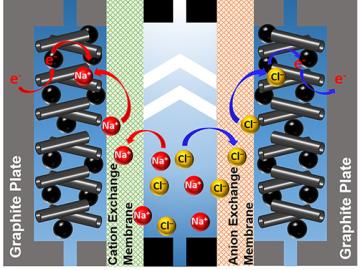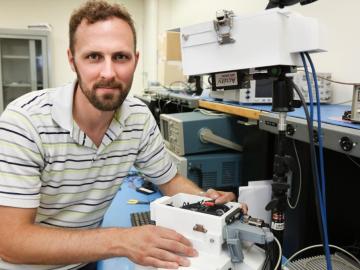
Filter News
Area of Research
- (-) Energy Science (94)
- (-) Nuclear Science and Technology (5)
- Advanced Manufacturing (6)
- Biology and Environment (36)
- Computational Biology (1)
- Computational Engineering (2)
- Computer Science (3)
- Energy Sciences (1)
- Fusion and Fission (6)
- Fusion Energy (2)
- Isotope Development and Production (1)
- Isotopes (20)
- Materials (90)
- Materials Characterization (1)
- Materials for Computing (14)
- Materials Under Extremes (1)
- Mathematics (1)
- National Security (23)
- Neutron Science (29)
- Quantum information Science (2)
- Sensors and Controls (1)
- Supercomputing (31)
- Transportation Systems (1)
News Type
News Topics
- (-) Biomedical (7)
- (-) Clean Water (6)
- (-) Coronavirus (10)
- (-) Cybersecurity (5)
- (-) Energy Storage (57)
- (-) Isotopes (4)
- (-) Materials Science (22)
- (-) Security (5)
- 3-D Printing/Advanced Manufacturing (63)
- Advanced Reactors (9)
- Artificial Intelligence (5)
- Big Data (3)
- Bioenergy (18)
- Biology (8)
- Biotechnology (3)
- Buildings (27)
- Chemical Sciences (11)
- Composites (14)
- Computer Science (20)
- Critical Materials (9)
- Environment (34)
- Exascale Computing (2)
- Fossil Energy (1)
- Frontier (1)
- Fusion (4)
- Grid (29)
- High-Performance Computing (3)
- Hydropower (2)
- Machine Learning (6)
- Materials (31)
- Mathematics (2)
- Mercury (3)
- Microscopy (7)
- Molten Salt (4)
- Nanotechnology (6)
- National Security (5)
- Neutron Science (11)
- Nuclear Energy (23)
- Partnerships (8)
- Physics (3)
- Polymers (10)
- Quantum Science (1)
- Simulation (2)
- Space Exploration (5)
- Statistics (1)
- Summit (3)
- Transportation (53)
Media Contacts

A team of researchers at Oak Ridge National Laboratory have demonstrated that designed synthetic polymers can serve as a high-performance binding material for next-generation lithium-ion batteries.

A team of scientists led by Oak Ridge National Laboratory used carbon nanotubes to improve a desalination process that attracts and removes ionic compounds such as salt from water using charged electrodes.

Oak Ridge National Laboratory scientists studying fuel cells as a potential alternative to internal combustion engines used sophisticated electron microscopy to investigate the benefits of replacing high-cost platinum with a lower cost, carbon-nitrogen-manganese-based catalyst.

As leader of the RF, Communications, and Cyber-Physical Security Group at Oak Ridge National Laboratory, Kerekes heads an accelerated lab-directed research program to build virtual models of critical infrastructure systems like the power grid that can be used to develop ways to detect and repel cyber-intrusion and to make the network resilient when disruption occurs.

Brixon, Inc., has exclusively licensed a multiparameter sensor technology from the Department of Energy’s Oak Ridge National Laboratory. The integrated platform uses various sensors that measure physical and environmental parameters and respond to standard security applications.

The Department of Energy’s Oak Ridge National Laboratory is now producing actinium-227 (Ac-227) to meet projected demand for a highly effective cancer drug through a 10-year contract between the U.S. DOE Isotope Program and Bayer.

A novel method developed at Oak Ridge National Laboratory creates supertough renewable plastic with improved manufacturability. Working with polylactic acid, a biobased plastic often used in packaging, textiles, biomedical implants and 3D printing, the research team added tiny amo...

With the production of 50 grams of plutonium-238, researchers at the Department of Energy’s Oak Ridge National Laboratory have restored a U.S. capability dormant for nearly 30 years and set the course to provide power for NASA and other missions.


